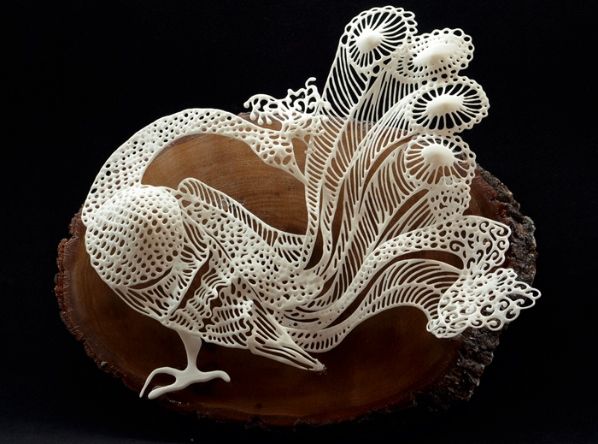The Art of 3D Printing: Creating Visual Masterpieces
The world of 3D printing is rapidly growing. It is now being used to create some truly amazing pieces of art. With it you can create almost anything imaginable in a matter of minutes. From intricate sculptures to stunning visual masterpieces. The art of 3D printing is truly remarkable, allowing creators to bring their wildest ideas to life. In this blog post, we will explore how it can be used to create stunning works of art. Techniques used by artists, the range of materials available, and the best places to find 3D printing artwork.
What is 3D printing?

3D printing is a relatively new technology that has the power to transform the world of design and manufacturing. At its core, It involves the creation of physical objects from digital strategies. This means that a 3D printer can take a computer-generated model and turn it into a tangible, three-dimensional object.
Software programs that are used to create 3D models, such as SketchUp Warehouse, 3DS Max, and Paint 3D. These programs allow designers to create incredibly intricate models with a high level of detail. Once a 3D model is created, it can be saved in a variety of file formats and uploaded to online repositories such as 3DWarehouse or 3DSky.
The possibilities of 3D printing are endless, from medical devices and prosthetics to creating custom jewelry and even printing food.
How does 3D printing work?

3D printing, also known as additive manufacturing, is a process that creates physical objects by building layers of material one on top of the other. The process involves using a 3D printer, which reads digital files containing the information needed to produce a 3D object. The digital file can be created from scratch using software such as SketchUp Warehouse or 3DS Max, or by scanning an existing object using a 3D scanner.
Once the digital file is ready, the 3D printer uses one of several methods to create the object. One popular method is fused deposition modeling (FDM), where the printer heats up a spool of plastic filament and extrudes it through a small nozzle. The nozzle moves around to create the object, layer by layer, based on the information contained in the digital file.
Another method is stereolithography (SLA), which uses a liquid resin that is cured by a laser to create the object. The printer shines the laser on the liquid resin, hardening it one layer at a time until the object is complete.
There are also other methods, including selective laser sintering (SLS) and electron beam melting (EBM), which use different materials and technologies to create 3D objects.
Once the object is complete, it can be further refined using software such as Paint 3D or 3DSky. The final product can be anything from a simple toy to a complex machine part. It has revolutionized the manufacturing industry and has enabled individuals and businesses to create custom objects quickly and affordably.
What are the benefits of 3D printing?
There are numerous benefits that’s why it has become such a popular technology in recent years. One of the most significant advantages is to create highly detailed and complex designs make with traditional manufacturing methods. It’s an ideal tool for architects, engineers, product designers, and artists looking to create intricate and unique pieces.
Additionally,It is much more efficient than traditional manufacturing, which can be time-consuming and costly. With 3D printing, designs can be created quickly and at a fraction of the cost of traditional manufacturing. This also makes it a great tool for prototyping and testing out new designs before committing to expensive manufacturing processes.

Another benefit of 3D printing is its accessibility. Rise of websites like 3dsky and 3dwarehouse, 3D models and designs are readily available to download. This makes it easy for hobbyists and DIY enthusiasts to get started with it and create their own custom designs.
One of the most exciting developments in 3D printing is the integration of technology with Paint 3D. This allows users to easily design and manipulate 3D objects on their computers, to create complex and precise designs.
Overall, 3D printing has revolutionized the way we think about manufacturing and design. Ability to create intricate and complex designs at a low cost makes it a valuable tool for professionals. Whether you’re looking to create art, functional objects, and is exciting and accessible way to bring your ideas to life.
What are the limitations of 3D printing?
Despite its numerous advantages, 3D printing does come with a few limitations. One of the most significant limitations is the size of the objects that can be printed. Most consumer-level 3D printers have a relatively small printing area, which restricts the size of the objects.
Another limitation of 3D printing is the materials that can be used. While there are a variety of materials available not all materials are suitable for every printing project. Some materials, like certain types of metals or plastics, require specialized equipment and can be expensive to work with.
Furthermore, the quality of the printed object may not always match that of the original design. Currently, a 3D model may not be printed with the same level of precision as a 3D model on a computer.
Although there are many free 3D models repositories such as 3D Warehouse or SketchUp Warehouse available, not all of them offer high-quality Therefore, users need to have some basic knowledge of how to optimize models for printing and an eye for good design and color choice or use specialized software like Paint 3D to finalize their creations.
